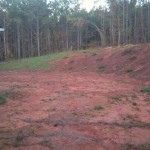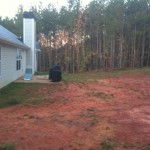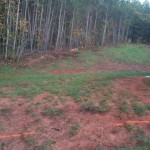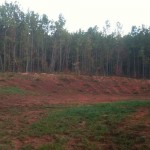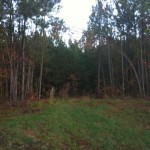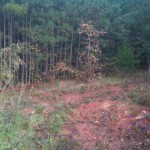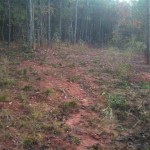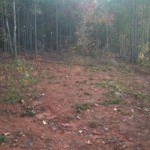We’ve lived in our house for a little over a year now and the back yard was a complete mess. There was hardly any grass, although the developers did “seed” it, most of the seed did not take. We basically had a mud pit for the past year. Mud pits are all fine and good, if you don’t have 9 animals tracking it in all the time. So, we spent some time doing some research and figuring out what our best options where. We decided to sod our back yard with 419 Bermuda. It’s the same type of sod in our front yard and we wanted it to match.
We talked to some people and I decided to sod it myself. We needed 16 pallets of sod, which was a pretty hefty goal – I just didn’t know it yet. We also have a hill that leads up into a clearing in the woods. This too was a big mud pit, which we decided to plant a shady mix of Fescue. Here is what our backyard looked like before we did any work:
One of my neighbors knows a guy who does some landscape work on the side, so we paid him to come and grade the backyard and the clearing. It took him about two hours total to grade everything, he did a really good job. We had a lot of issue with washout when it was just mud, but luckily he was able to fill it in and level it off a lot. Here’s what it looked like right after being graded:
Almost immediately after he finished grading the first sod truck came to deliver 10 pallets of sod. We had 16 coming, but they said each pallet weighs so much that they’d be breaking some laws to transport all 16 in one haul. I asked them to scatter the pallets in the back yard. This was a big help in the sodding process. For the most part I only had to walk 10 or so feet from the pallet to where I was dropping the sod. When you order your sod, you can usually choose it to be delivered in two forms — rolls or slabs. Rolls are basically three slabs in a roll, so three times as much weight. The sod vendor recommended that I get slabs, because “after a day of laying it, you’ll appreciate only having to lift one slab.” I took a picture of a single pallet of sod and what the yard looked like after 10, then 16 pallets were delivered:
It was around noon on Saturday when all the sod was delivered. I did some research before laying the sod to find proper methods. The only real thing that I found was that you should lay the sod in a brickwork pattern. Although laying sod is relatively easy, it is an extremely tedious task. You do a lot of walking, bending, lifting, kicking, stomping. I also noticed that I had these weird reoccurring patterns when trying to keep the “brickwork” pattern. Eventually it would become more and more uneven and I’d have to cut a piece in half to start the brickwork pattern over again.
The only real tool I used was a machete for cutting the pieces in half, or for cutting pieces to fill in any gaps that propped up. It worked really well for my purposes and I found that I could use the blunt side of the blade to whack things into place. I also wore some knee pads (which I saw someone online doing) but those became a nuisance. I ended up getting dirt between the knee pad and my knee and it just started to get uncomfortable. So I stopped wearing them and decided if I needed to kneel down, I’d just kneel on some sod. Lastly, I purchased some gloves to protect my hands. I was pretty happy with that purchase, the gloves I got gave me some extra grip and really helped my hands from being stained red by Georgia mud. Other than that, the only thing you’ll be doing is lifting, walking, dropping, kicking, stomping; lifting, walking, dropping, kicking, stomping.
It took me 3 days to do all 16 pallets by myself. After the sod was delivered at noon on Saturday, I worked until 6PM and had finished 5 pallets. Sunday, I was able to do 7 more pallets. I probably could have done more, but I spent some time filling in gaps and stuff which probably should have waited until the end. Monday, I finished off the last 4 pallets and spent the rest of the day filling in the rest of the gaps and setting up a watering system. Here are some pictures of my progress during these three days:
Technically you’re suppose to “roll” the sod when you’re done. They have a tool called a “sod rollers” that you use to roll over the sod with. Basically it’s nothing more than an empty barrel with a handle to pull/push it. You fill the barrel with water and just roll over the sod. The reason you do this is to press the roots into the existing soil to help the sod take. I was advised to get the sod nice and wet before rolling it. That way it sticks in the existing soil better. Hurricane Ida was on her way, so I let her soak the sod real good for me. Then I rented a sod roller from Sunbelt, the rental place at Lowe’s. It was 14$ to rent the roller for the day and took me about an hour to do the whole yard.
All things considered, I feel like it was a good experience and I saved over 1500$ by doing it myself. Plus because I bought the sod during an off season I got a really good price per pallet. The only labor I paid for was the guy who graded my yard. Kati helped by spreading the seed in the clearing. She did a great job, basically she needed to spread the seed with our seed spreader, lightly rake it, and throw some hay on top. The hay is to help prevent birds from eating the seed. I bought four bails of hay to cover 2,000 sq. ft. because the guy at Lowe’s said one bail covered 300-400 sq. ft. As it turns out, one bail covers about 2,000 sq. ft. So now I have three bails of hay just sitting there. Oh and I’m now accepting donations for a riding lawn mower :). Anyways, here are the pictures of the final results:

